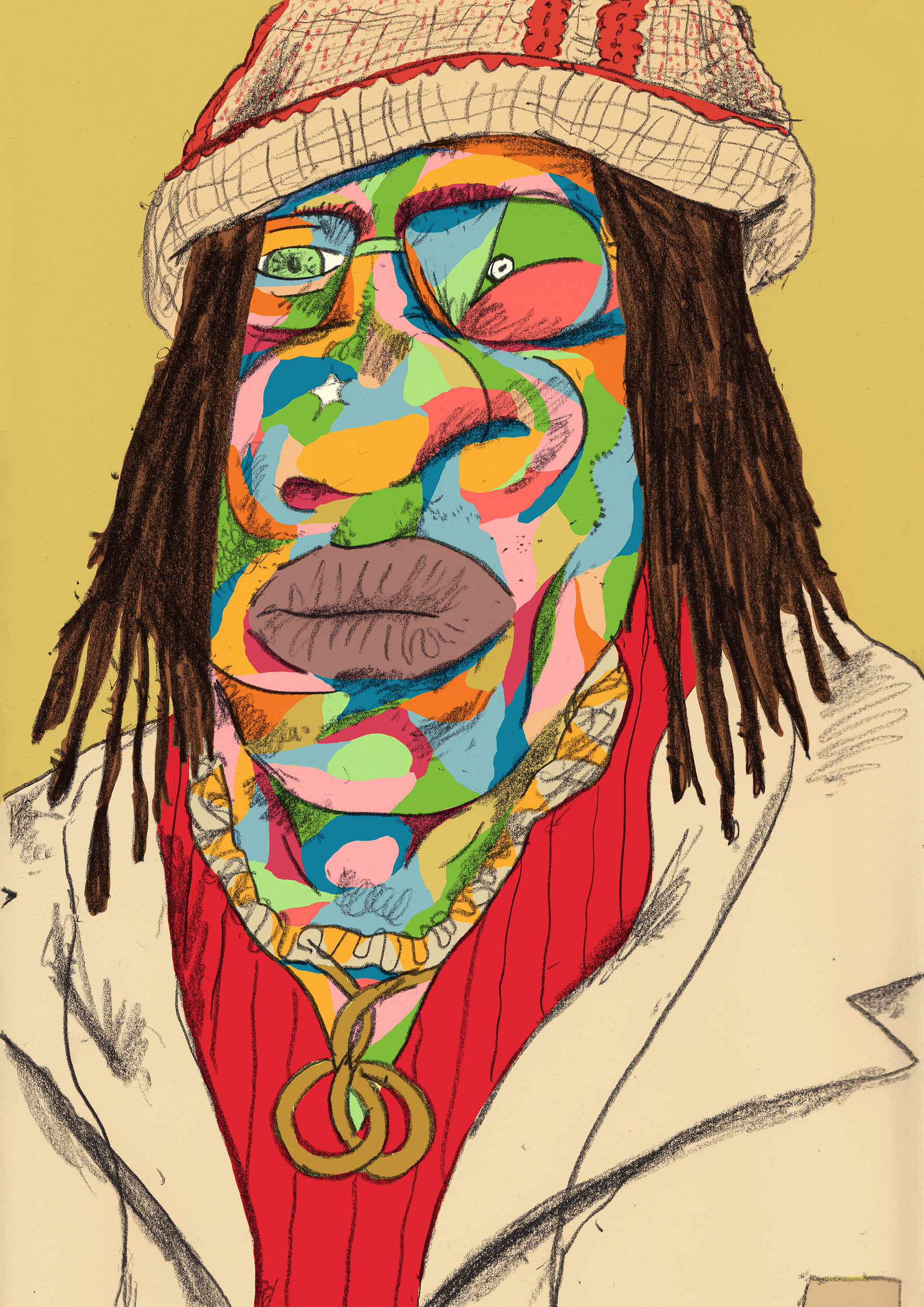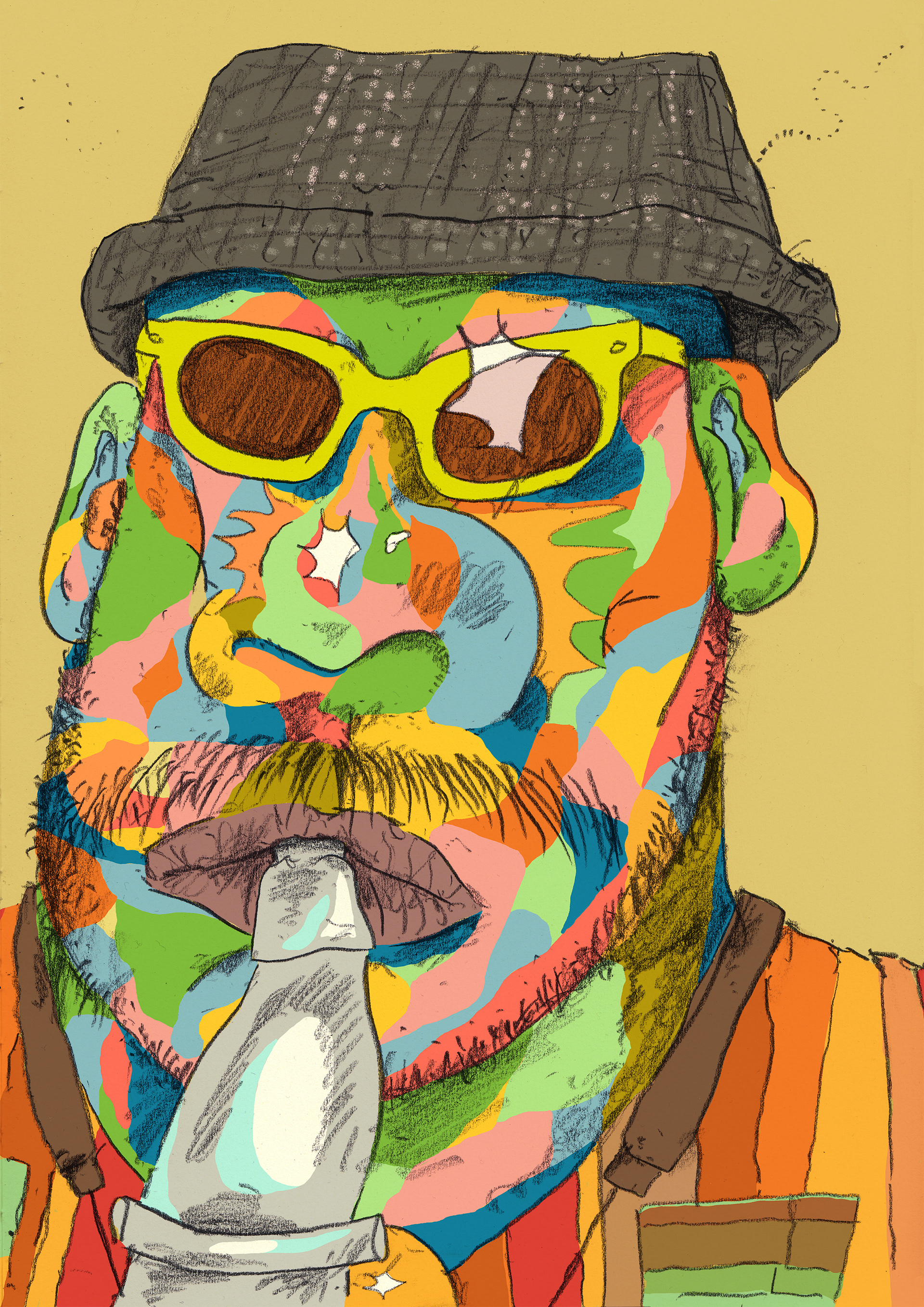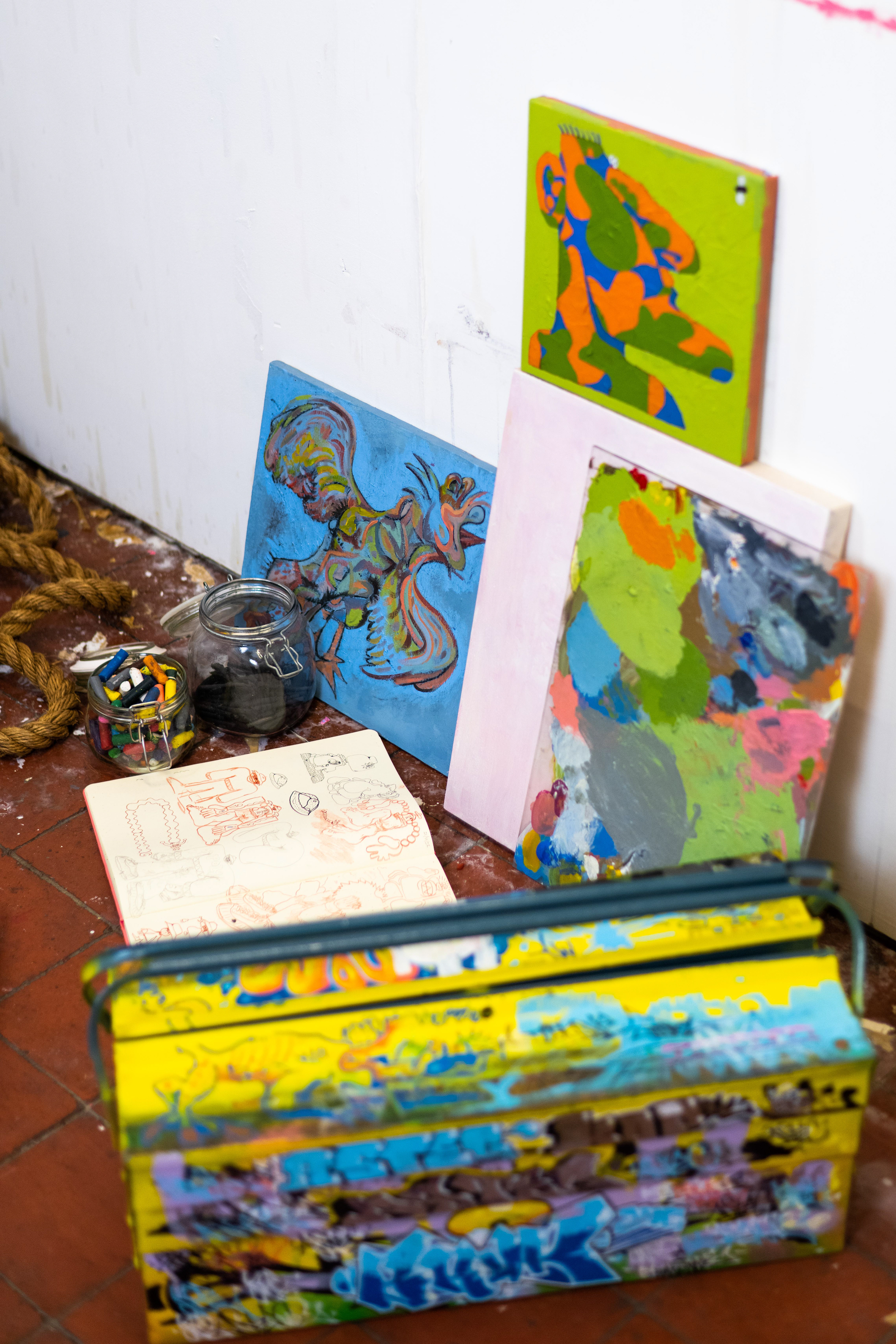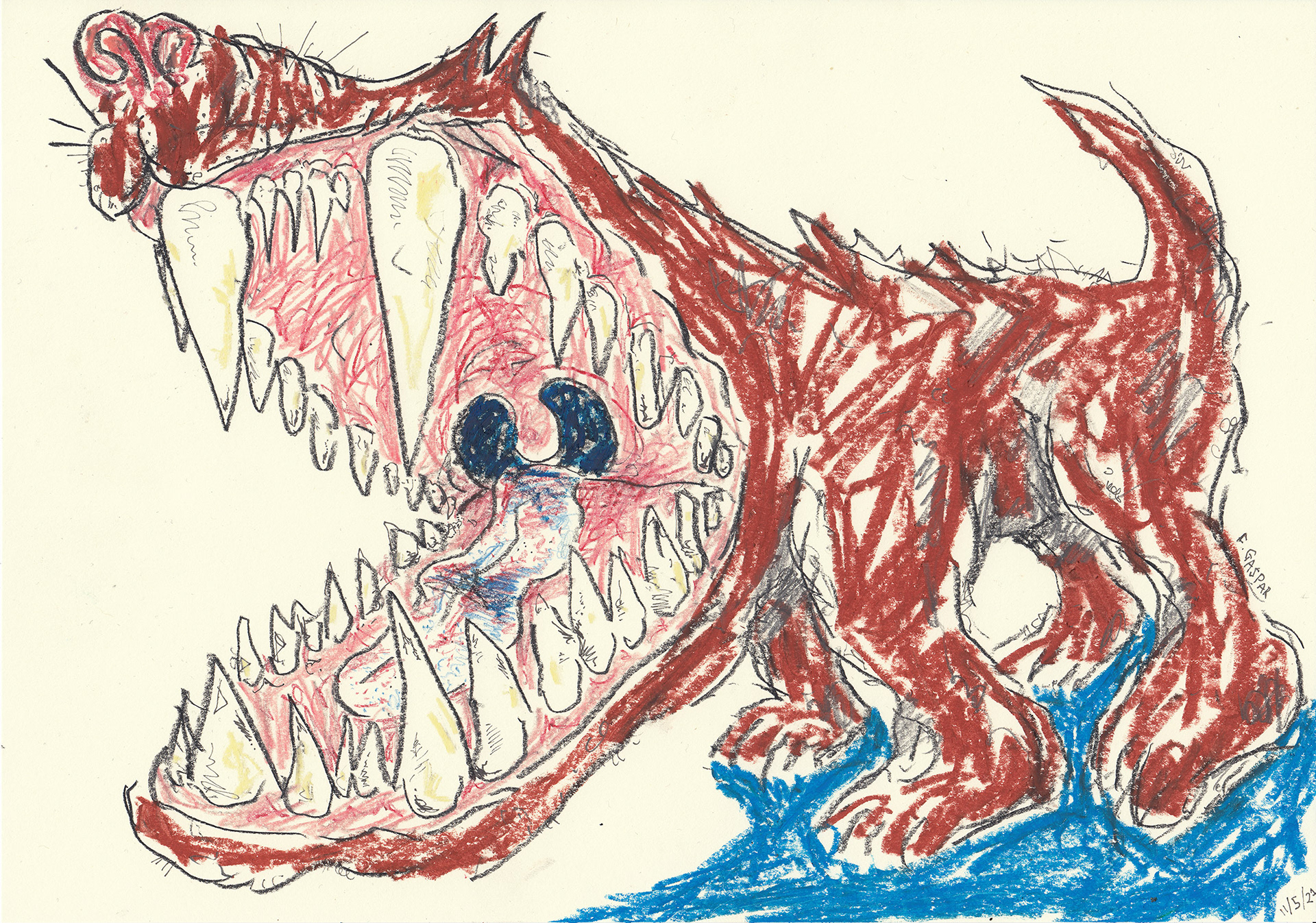27th January 2023 - Written By Louis Norton
An interview with Finlay Gaspar, a product of his environment.
Shot by Lewis Chetcuti
For the inaugural episode of Spotlight, I talked to Finlay Gaspar, an illustrator/ designer/ photographer currently located in Manchester. In his art, he plays with real and imagined worlds. His work bursts with colour and chaos, but when I shot over some questions Q&A style, he answered with composure and rationality.
You describe yourself as “an anti-specialist within your practice”- that’s a quote from your website - can you shed some light on what that means?
I describe myself as an anti-specialist to ensure I don’t confine my creative abilities to a certain practice. My ideas for art, design and illustration are constructed without limitations on what mediums I use.
Your work seems predominantly abstract, with a connection to the graffiti scene of Manchester and urban ideology. How much does where you live inspire your work?
I’m a product of my surroundings. My environment constructs my entire thought process and has done since my first project at university. The Manchester Canal became my second home for a short while when I was tasked with creating on location. Slowly I became adjusted to its environment, until I was living and breathing its experiences daily. Stories and narrative, graffiti and motion-movement led to further research into cartoonists and the practice of abstract expressionism, to now, where my learnings are engraved deep in my drawing style.
I find my inspiration by documenting sights that instantly spark interest with their visuals, and as much as I am able to do this in my hometown of Manchester, I feel it is important for an artist to travel. Fresh surroundings and experiences are fresh influences on my art and so I look to being inspired by some new cities this year.
I find my inspiration by documenting sights that instantly spark interest with their visuals, and as much as I am able to do this in my hometown of Manchester, I feel it is important for an artist to travel. Fresh surroundings and experiences are fresh influences on my art and so I look to being inspired by some new cities this year.


You seem to couch your abstract ideas within recognisable elements; animals, people and familiar body shapes with surreal colours and mutations- this push and pull between symbolic and literal. How did you develop this motif and what’s so rewarding about it? Do you plan your pieces out in advance or rather start drawing and see where a piece will take you?
My style is an amalgamation of everything I have done creatively. I guess my journey started by locking myself in my bedroom for the summer holidays to focus solely on improving my drawing abilities. I used my imagination to create an alternate world whilst focusing on developing characters regularly. When I started at university I scrapped everything I had developed and wiped the slate clean to open myself up to trying new things. This is when I started challenging myself creatively, with the help of my university tutor who taught me to focus on my thoughts and dreams in order to stretch reality within life drawing. This practice then followed me throughout university, leading to heavy research into abstract expressionism, lyrical abstraction, visualising sound, and automatism.
I’ve never been inspired to create realism. Imagination, dreamlike narratives and ambiguity are what have always attracted me. Automatism led me to create what I wanted to see and gave me a deeper understanding of my attraction to biomorphic and geometric shapes as well as line, texture, pattern, perspectives, and time. Describing gospel and its form of free creation, Questlove said in the Summer of Soul documentary that it “was an eruption to arrive at peace with spirit by being completely expressively open.” I’m now at a point where I can let the drawing lead its own path, often starting from textural movement to depict what’s in front of me at the time, then looking at the paper from afar to develop what I see into something more distinguishable. I guess the uncertainty of what I produce keeps me attracted to working with a balance of structure and free nature in this eclectic process. On the other hand, for illustrative and design projects, I take on a more formal, research-based approach, whilst experimenting with a range of materials until I land on a final process that works with the concept.



Which artists do you count as major inspirations in figuring out your own style?
Philip Guston and his use of colour and abstract figurative work, Joan Miró for helping me develop my automatism and understanding myself visually. Rammellzee for inspiration in creating new worlds, and so many more; from the likes of Paul Klee, Max Ernst, Georges Mathieu, Guiseppe, Acrimboldo, Eileen Agar, Rufino Tamayo, Henry Moore, Sarah moon, the list just goes on.”
Do other art forms influence your process? Do you listen to music whilst you’re working on a project?
Art forms like music, fashion and film are what got me into creating in the first place, from art directed fashion shoots of my favourite music artists or clothing brands, to album covers and film posters. Music is especially essential to my creative practice. After a few years of illustrating sound during my degree, I’ve become quite familiar to how sound affects your emotions, at times it just keeps me inspired to create, and at peace when drawing. I don’t think I could live without music and I definitely couldn’t draw without it. I’ve always got a vinyl spinning when I’m creating and if not music, there’s usually a film on.
What’s your process like in a digital sense? Do sketches come first and photoshop comes after?
Mostly, the idea will start with a sketch, and a few more drawings until I find one that captures my eye the most. Then I scan through the drawing, create a colour palette from my downloaded stash of pantones, and colour in from there.
I’ve been using Adobe creative suite for about 10 years now, most of my youth was spent playing around on photoshop, editing, collaging photos, and doodling on my computer. Sometimes I find it quite refreshing to stare at a blank page, go through my archive of photos and textural scans I’ve collected over the years, and feel free to create something I wouldn’t have expected to.
My favourite piece of yours is the “Man on the Moon” single cover for Limbo Days. When working to a brief like that, how does the process feel using lyrics to guide you?
Music artists often find their way into my creative ideas. Lyrics are quite visual in themselves; their descriptiveness helps me to portray an array of ideas in a single cover. Working with artists is something that I’ve always wanted to do. So I just take on each challenge as it comes and rely on communication with musicians to regularly keep them in the loop.
“Man on the Moon” EP cover by Limbo Days
You’re also a photographer, which you could argue is a literal medium. Does this allow you to explore things you may be unable to in your illustrations?
Photography is something I started doing throughout high school, I even still use the first camera I bought at 13. Learning photoshop at a young age, I started experimenting with photos, layering archive scans and seeing how much I could distort things from their original states. Photography is a literal medium, sometimes I leave images as they are if I see beauty in them, but when I stare at my photo archive on my computer, I start to see the potential of what I can achieve post production, knowing that these images could be so much more.
Throughout my studies I explored collage, and that’s where I blended it into my illustration work. I would use shadows from photographs or elements that I could see looked like body parts (sometimes my physical body too), and work with that to develop abstract portraits. My mode of creating in that way was deep-rooted in research on the Arcimboldo effect. At the time, I think the textural layers within photos, and collaging with them made it more visually appealing than working with block colours.

What’s the hardest aspect about being an artist for you?
Right now, I’d probably say understanding who I am as an artist. I think having so many different methods of creating work is a blessing and a curse as a creative. It makes me versatile, but I lack a signature style in a world that demands to see distinctive and repetitive work.
Do you see your work as dark or hopeful?
“The more terrible this world (like todays, for example), the more abstract our art, whereas a happy world produces art from the here and now” – Paul Klee (Diaries 951)
What’s next?
There are a couple of plans in the works. Branching out into designing for the fashion and product industries is something I have been wanting to do for a while. I also plan on creating more album covers, posters, and even some animation work.